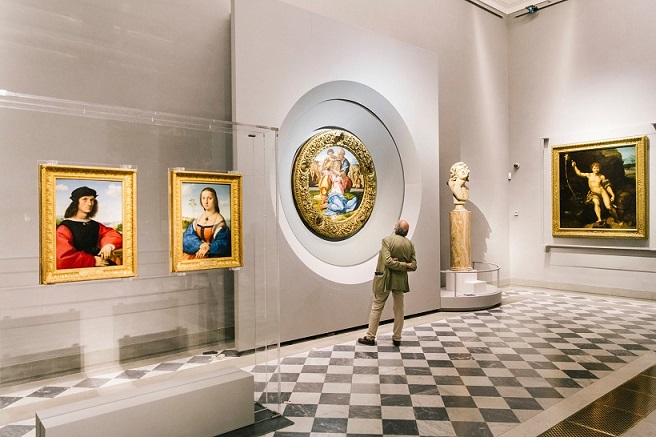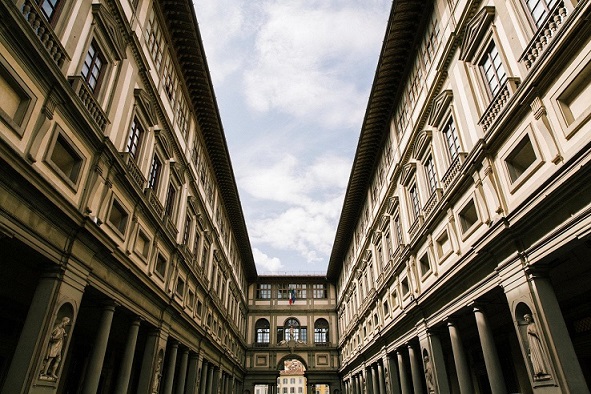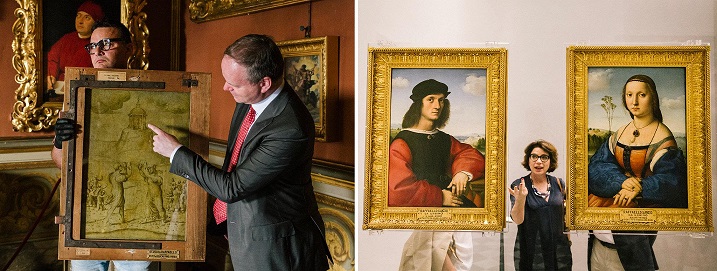
Left: The iron keys to the door of the Vasari corridor, a nearly half-mile-long passageway that links the Palazzo Pitti to the Uffizi. Right: Museum workers in the Vasari corridor.CreditGianni Cipriano for The New York Times
The Raphael and Michaelangelo room is meant to capture a rare moment in Florentine history when the Medici family, the dynasty that ruled from 1434 to 1737 with a few interruptions, did not dominate the city’s politics and culture. Between 1498 and 1512, the family was in exile and Florence became a republic under Piero Soderini. Artists who once flocked to the Medici turned to other patrons “who competed to procure the most masterpieces,” Mr. Schmidt said. “It’s a reconstruction of the patrons who tried to outdo each other.” Apart from the popes Julius II and Leo X, only the Doni family managed to commission works from both Raphael and Michelangelo.
Mr. Schmidt has positioned a Hellenistic-era head known as the Dying Alexander next to the Doni Tondo, in part to accentuate Michelangelo’s relationship to antique sculpture. The Uffizi has one of the world’s greatest collections of antique sculpture, though it is often dwarfed by the richness of the painting collection.
Raphael’s “Madonna of the Goldfinch,” also in this room, was painted for the Nasi family, another prominent dynasty of the time. It has been moved here from a long corridor in the gallery so packed with paintings that many visitors paid it no attention.
The new arrangement also hopes to shed a fresh spotlight on Fra Bartolommeo (1473-1517), a Dominican friar and Raphael acolyte who “never had the same critical fortune” as his more famous contemporaries, Mr. Schmidt said. There are three works by him in the room, “another great artist of the time,” he said.
Placing masterpieces alongside lesser known works also creates a visual and intellectual rhythm, Mr. Schmidt said. “It’s like music in a symphony; you can’t play fortissimo all of the time,” he added.
The German-born Uffizi director began rehanging the museum’s headliners in October 2016 — his predecessor Antonio Natali also made changes in the museum — with a rearrangement of the rooms for Botticelli and other late-15th-century artists. In February this year, the Uffizi opened nine rooms dedicated to Caravaggio, his followers and other 17th-century masters, including Rembrandt and Rubens. The following month the museum refurbished rooms containing works by Bernini to Goya.

The area in the Palazzo Pitti where Raphael’s dual portraits used to hang. Grumblings quickly erupted on social media saying that the Pitti has lost two of its superstars.CreditGianni Cipriano for The New York Times
On Monday, grumblings were already erupting on social media that the Pitti — which has the world’s largest collection of Raphaels — has lost two of its superstars.
Mr. Schmidt has tried to appease critics by pointing out that three works by Raphael, “Portrait of a Young Man with Apple,” and portraits of Julius II and Leo X would be given in exchange from the Uffizi to the Pitti. (The director noted that he had chosen to transfer the paintings on the first Sunday of the month, when admission to the museum is free, because he didn’t want to put up with the complaints from disappointed visitors. “I’ve had people telling me ‘I’ve come from Canada to see the school of the master of whatever, and it’s on loan,’ ” he laughed. “I wanted to avoid all that.”)During his time as director, which will end in December 2019, when he is scheduled to move to the Kunsthistorisches Museum in Vienna, he has presented a series of initiatives to open the storied museum to more contemporary multimedia experiences including live performances every Tuesday evening. And he recently returned from a trip to China. Is a Shanghai Uffizi on the horizon, along the lines of the Louvre Abu Dhabi?
Mr. Schmidt said he thought not, at least for now. “There’s certainly strong interest in collaborations, but nothing is in the pipeline yet,” he said.
For the moment, he is focusing his energies on the new layout of Florence’s golden age.
“See if you like it,” Mr. Schmidt said of his project. “And if you don’t, it’s too late anyways,” he added with a grin.







